When Microsoft pushed its March 2025 Windows updates, millions of users woke up to find their AI assistant gone — not disabled, not hidden, but uninstalled. The March 2025 Patch Tuesday update, specifically KB5053598 for Windows 11 24H2 and KB5053606 for Windows 10 22H2, triggered a silent, automatic removal of the Copilot app from the taskbar and system. It wasn’t a feature. It was a bug. And it happened right after the U.S. House of Representatives banned its staff from using Copilot over fears of sensitive data leaking into Microsoft’s cloud. The twist? Microsoft didn’t even realize the problem until users started flooding forums.
What Went Wrong — And Why It Mattered
The issue wasn’t just inconvenient. For many, Copilot had become the default way to check weather, summarize emails, or even draft meeting notes. When it vanished overnight, productivity took a hit. One Windows Insider on Microsoft’s own support forum wrote: "I have uninstalled it from Windows as I cannot waste time fact checking it's answers every time. That is not an assistant — that’s a time-wasting liability." The frustration wasn’t isolated. Dozens of users reported the same thing: Copilot gave wrong football scores, misquoted legislation, and stubbornly repeated errors even after corrections. Microsoft’s official response came within 72 hours: "We're aware of an issue with the Microsoft Copilot app affecting some devices. The app is unintentionally uninstalled and unpinned from the taskbar." Crucially, they clarified that the Microsoft 365 Copilot — used in business environments — was unaffected. But that didn’t calm enterprise users. Security researchers at Concentric AI had already flagged deeper problems months before the bug surfaced.Security Risks Run Deeper Than a Missing App
Concentric AI’s analysis, published in February 2025, revealed a pattern of dangerous oversights. Copilot, they found, inherited excessive permissions from users — meaning if you had admin rights, so did Copilot. It lost document classification labels when generating summaries. Worse, a server-side request forgery (SSRF) vulnerability in Copilot Studio could let attackers probe internal networks through AI-generated HTTP requests. Microsoft patched the SSRF flaw within days of disclosure, but the damage to trust was done. The U.S. House of Representatives ban in early March wasn’t random. It was the culmination of months of internal warnings. Congressional staff had been using Copilot to draft memos, summarize briefings, and even generate constituent replies — all while feeding classified or sensitive data into an AI trained on public internet sources. No one knew what got uploaded. No one could audit it. The ban was a wake-up call: AI assistants aren’t just tools. They’re data conduits.
The Backlash and the Pivot
Microsoft didn’t ignore the outcry. In April, they launched an internal security review. By June, they pulled the plug on GPT Builder, the feature that let users create custom Copilot models. It was too easy to accidentally train a bot on confidential files. Then came the Recall feature — initially enabled by default, it recorded everything users did on their PCs. After backlash, Microsoft made it opt-in. A rare admission of misstep. Even the voice-activated Copilot, introduced in February 2025 and triggered by Alt + Spacebar, faced reliability issues. Users reported it misheard commands, interrupted conversations, and sometimes responded with gibberish. "It’s like having a very enthusiastic intern who doesn’t read the room," one IT manager told Windows Forum. And then there was the Windows Server 2025 preview. Copilot briefly appeared there — then vanished. Administrators revolted. "You don’t put a consumer AI assistant on a domain controller," one senior sysadmin wrote. Microsoft quietly removed it.What Microsoft Is Doing Now — And What’s Next
At Ignite 2025, Microsoft’s John Cable, Corporate Vice President for Windows Planning and Implementation, unveiled a new strategy: not just AI in Windows, but AI under control. The centerpiece? Windows 365 for Agents, which lets AI processes run inside isolated Cloud PCs — no direct access to local files. They also introduced native support for the Model Context Protocol (MCP), a framework designed to give enterprises precise control over what data AI can access. New APIs like Video Super Resolution (VSR) and Stable Diffusion XL (SDXL) are being baked into Windows for local AI rendering — reducing reliance on cloud processing. And by Q3 2025, Microsoft plans to roll out Copilot+ PCs — hardware optimized for on-device AI, with dedicated NPUs and strict data isolation. The message is clear: Microsoft isn’t backing off AI. But it’s learning the hard way that speed without safety is a liability.
Why This Isn’t Just a Microsoft Problem
This isn’t just about Copilot. It’s about the broader reckoning happening across tech. Every major company is racing to ship AI features — but few are building the guardrails. The U.S. House of Representatives ban wasn’t anti-tech. It was anti-recklessness. And users aren’t asking for more AI. They’re asking for AI that doesn’t lie, doesn’t leak, and doesn’t break. Microsoft’s response — patching bugs, pulling features, adding controls — shows they’re listening. But trust isn’t rebuilt with patches. It’s rebuilt with consistency. And right now, Copilot feels more like a prototype than a product.Frequently Asked Questions
Did the March 2025 Copilot bug affect all Windows users?
No. The bug only affected systems updated with KB5053598 (Windows 11 24H2) or KB5053606 (Windows 10 22H2). Devices on older builds or those with Microsoft 365 Copilot were untouched. Microsoft rolled out a patch within five days, restoring the app automatically for most users.
Why did the U.S. House ban Copilot?
Security researchers at Concentric AI found Copilot could inadvertently upload sensitive congressional documents to Microsoft’s cloud servers during routine use. With no audit trail or data classification enforcement, staff risked leaking classified briefings, constituent data, or legislative drafts — a violation of House cybersecurity protocols.
Is Copilot still unsafe to use today?
For personal use, risks are lower but still present — especially if you’re sharing sensitive documents. Microsoft now enforces least-privilege permissions and post-output labeling, but the core issue remains: AI hallucinates. Always verify critical outputs. For enterprises, use Windows 365 for Agents or Copilot+ PCs with strict data isolation.
What’s the difference between Copilot and Microsoft 365 Copilot?
The free Copilot in Windows 10/11 runs on consumer-grade AI and has broad access to your device. Microsoft 365 Copilot is designed for business, integrates with SharePoint and Teams, and enforces compliance policies. It’s governed by enterprise data loss prevention rules — and it’s not affected by the March 2025 uninstall bug.
Will Copilot+ PCs fix these issues?
They’re designed to. Copilot+ PCs use dedicated NPUs to run AI locally, reducing cloud dependency. They enforce hardware-level data isolation and only allow AI to access files explicitly permitted by policy. If Microsoft delivers on these promises, this could be the first truly enterprise-ready AI PC platform.
What should users do if Copilot keeps giving wrong answers?
Don’t rely on it for facts. Treat it like a brainstorming partner — not a librarian. Use it for drafting, not decision-making. For time-sensitive or critical tasks, always cross-check with trusted sources. Microsoft admits Copilot still hallucinates; users should too.
